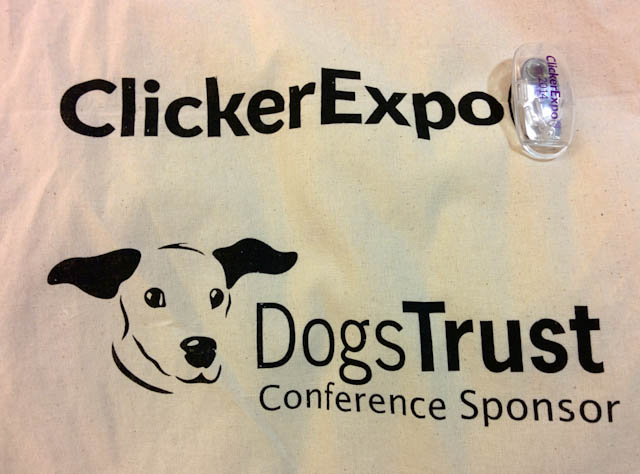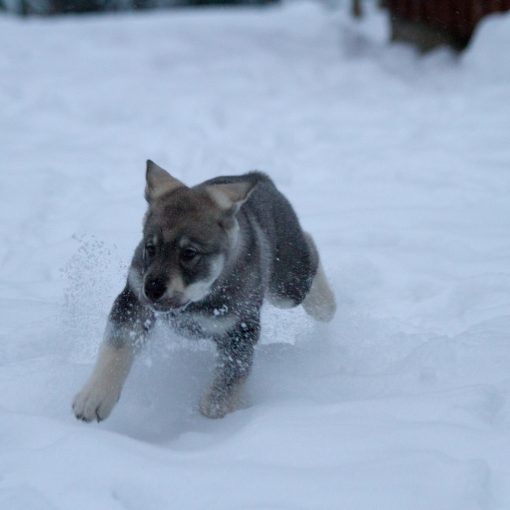Vuosi sitten ilmoittauduin ”early birdinä” mukaan Clicker Expoon, joka nyt ensimmäistä kertaa pidettiin Euroopassa 17.-19.10.2014. Clicker Expon historiasta voisi mainita sen verran, että kymmenen vuoden ajan (kaksi / vuosi) se on järjestetty Yhdysvalloissa tarkoituksena levittää positiivisen vahvistamisen ideologiaa koiran / eläinten kouluttamisessa. Nyt vihdoin Karen Pryor Clicker Training sekä Positive Animal Solutions järjestivät vastaavan tapahtuman ensimmäistä kertaa täällä Euroopassa.
Kun sain kuulla tästä ensimmäisen kerran, en epäröinyt laisinkaan, vaan heti ilmoittautumisen avautuessa olin valmiina rekisteröitymään mukaan. Ja siitä alkoi odottaminen, joka viimein huipentui lokakuun puolivälissä tapahtuvaan matkaan Englannin Boltoniin.
Matkaan lähdimme jo torstaina, jolloin lensimme suoraan Helsinki-Vantaalta Manchesteriin. Sieltä sitten jatkoimme autolla yöpymispaikkaamme The Mercure Last Drop Village Hotel & Spahan, missä myös Clicker Expo pidettiin perjantain ja sunnuntain välisenä aikana.

Luento- ja labisuunnitelmat

Ilmoittautumisen yhteydessä olin varannut paikat labeihin (max kolme), ja niiden perusteella olin kaavaillut lopun expo-ohjelmistoni. Suunnitelmani koostui Ken Ramirezin luennoista (4 kpl) sekä labeista (2 kpl), Michele Pouliotin luennosta (1 kpl), Cecilie Kosten labista (1 kpl) sekä Karen Pryorin luennoista. Olisi ollut kyllä kiva käydä kuuntelemassa ja katsomassa muitakin luennoitsijoita, mutta ajankohdat osuivat ikävästi näiden muiden kanssa päällekkäin, joten näin tällä kertaa (samaan aikaan tarjolla oli kaksi luentoa ja yksi lab).
Seuraavassa lyhyesti valitsemieni luentojen ja labien esittelytekstit (napattu ClickerExpon sivuilta):
1. päivä – 17.10.2014
Welcome to ClickerExpo!
Karen Pryor, Aaron ClaytonAaron Clayton and Karen Pryor welcome you to ClickerExpo with a preview of the program, opening remarks and introductions to help you navigate ClickerExpo successfully and enjoy your time to the fullest.
Big and Tall, Round or Small? Modifier Cues & How to Teach Them
Ken RamirezAt the Shedd Aquarium in Chicago where Ken Ramirez is vice president of Animal Collections and Animal Training, marine mammal trainers make use of modifier cues to indicate specific behaviors. Left and right are good examples that can be applied to objects (fetch the left object), actions (jump the left bar), body parts (give me your left flipper—or paw, if you’re a sea otter). Modifiers need not be limited to two alternatives; cues can be developed that identify targets or objects as large, medium, and small.
In addition to marine mammals, Ken Ramirez has employed modifier cues with dogs, steering search and rescue dogs at a distance, for example. Ken will discuss and show on video training procedures for developing modifier cues with both marine mammals and dogs, and will suggest some of the many applications of this sophisticated tool.
Big and Tall, Round or Small? Modifier Cues & How to Teach Them in Action (lab)
Ken RamirezParticipant notes:
Dogs in this class should have a well-established retrieve and/or numerous clicker trained on-cue behaviors. Dog and handler should both be experienced and comfortable with freeshaping. You may participate with your dog or you may attend as an observer. Handlers must attend the prerequisite Learning Session in order to participate. Observers at all levels of experience are welcome. Observers should not bring dogs to the Lab.Modifier cues are an advanced concept. Once you can get an animal to understand a couple of concepts—left and right, for example—and to understand the idea of a concept, you can move forward very fast. Dogs learn to generalize their knowledge, which is a huge advantage in advanced training.
This Learning Lab provides the opportunity to begin to practice what you learned in the Learning Session that is a prerequisite to this Lab. Participating dog/handler teams will practice with their own dogs the core techniques used in the Learning Session.
Hidden Aversives Drawbacks of Negative Reinforcement & Extinction
Karen PryorFor thousands of years, people have been tending and using animals, driving and herding them, riding, leading, and steering them. The tools we use are worldwide and millennia-old: bits, bridles and reins, goads, prods, whips, collars, and leashes.
…
Rather than equating negative and positive reinforcement as two sides of the same coin, Karen Pryor suggests that negative reinforcement creates a continuing underlying state of stress in the learner, and consequently has little place in modern training practice. In this Session, she will give examples of circumstances in which negative reinforcement can be valuable as an initial tactic when positive reinforcement is impossible, as when an animal is too fearful to approach.
…
In this Session, Karen will discuss how to recognize when you are accidentally triggering extinction bursts, as well as some reinforcement-based alternatives to the unnecessary cruelty of deliberately induced extinction.
2. päivä – 18.10.2014
Love it! Effective Non-Food Reinforcement
Ken RamirezReinforcement is the key to successful training—most trainers already know that. Most experienced trainers reach a point where they find themselves using reinforcers other than food. Even beginning trainers will often use toys, praise, and other alternative reinforcers. This seemingly simple concept can be a valuable tool for the informed trainer—but it can also be the cause of serious problems and behavioral breakdown.
This Session will explore the science of conditioning new reinforcers, the practical use of variable reinforcement strategies, and a method for determining when use is as effective as it could be for your animal and situation.
In this Session, attendees will learn the science and practice behind various reinforcement strategies as well as systematic techniques for implementing new strategies so that they are successful. This Session will include a detailed explanation of the process and plenty of video examples.
Pace, Place & More Strategic Reinforcement Delievery
Michele PouliotEffective clicker training is sometimes thought of as exclusively depending on the timing of the click and the value of the reinforcer. An often-overlooked subject is reward delivery. How, where, and when rewards are delivered is crucial to efficient and clear training because it is a key linchpin in the communication cycle you are creating. Implicit in ”Click, then treat” is all of the activity that happens in ”then.” For example, while most beginners know that starting to reach into the bait bag before the click is completed can weaken the power in the click, even experienced trainers don’t always understand other critical effects of reward delivery on learning.
Strategic reward delivery includes how reward delivery can be used to either lower or increase a dog’s energy, how the makeup of the physical reward itself can enhance or hinder the reward process, whether the placement of reinforcement should support the goal behavior or be used to reset the dog for another repetition, and how teaching a dog to tolerate occasional longer reward sequences can allow for flexibility without dampening the reinforcement process. Finally, strategic reward delivery means being conscious of the choices you are making and how they impact your dog’s learning.
Love it! Effective Non-Food Reinforcement In Action (lab)
Ken RamirezParticipant notes:
All participating dogs should be clicker-savvy, have a robust behavioral repertoire, and already use toys or play as a reinforcer regularly and effectively. While Lab participation may be appropriate for less experienced trainers, it is not recommended for novice clicker trainers as the exercises can be complex. Handlers must attend the prerequisite Learning Session in order to participate. Observers at all levels of experience are welcome. Observers should not bring dogs to the Lab.The effective use of non-food reinforcers is a critical skill that all trainers will likely use or need at some point in their training careers. Being able to use non-food reinforcers is extremely useful, but requires an understanding of their role in training as well as a well-thought-out training approach. This stand-alone Lab focuses on two main practical aspects of using non-food reinforcers: how novel stimuli, like clapping and verbal praise, become reinforcers, and how to maximize the use of play and toys.
Dog/handler teams will have the opportunity to start training novel stimuli as reinforcers and gain valuable insight from Ken as to how to maintain the strength of these unique reinforcers. In the latter half of the Lab, the focus will be on using play and toys as reinforcers — demonstrating their use with participating dogs as well as maintaining and evaluating their effectiveness.
This Learning Lab provides the opportunity to begin to practice what was learned in the Learning Session (a prerequisite to this Lab). Participating dog/handler teams will practice with their own dogs the core techniques used in the Learning Session. Observers and dog/handler teams will all receive valuable tips and strategies for making non-food reinforcers more effective. The Lab will include a step-by-step demonstration of how to teach new reinforcers to an animal.
Room With a View Point A Moderated Panel Discussion With Faculty
Join some of your favorite ClickerExpo stars as they argue, banter, and reveal their own opinions and experiences about issues in the forefront of the training world today. When they relax and say what they think, these folks are both insightful and funny! This get-together is a ”don’t miss it” event that brings people back to ClickerExpo year after year.
Friendly Takeover: The Growing Influence of All of Us
Karen PryorPeople often proclaim that clicker trainers are changing the world of dog training, and indeed we see new evidence of that fact every day. Judging by the number of new books, DVDs, and YouTube videos, the clicker community is also changing the world of horses, cats, zoo animals, and even fish. Do you realize that we are changing a lot more than that? Every time you help a pet owner catch on to the concepts, every time you share a clicker story with your neighbor, your veterinarian, or your in-laws, and every time you put a clicker video on your Facebook page—you are widening the circle of awareness. The outcome? More and more people who don’t work with animals at all are reaching out to us for help.
In her special Saturday night talk, Karen Pryor will share some of the current projects and personalities she is working with, including: a conductor who wants to make rehearsals more efficient and music education less punitive, doctors bringing shaping and reinforcement (instead of yelling) into the training of interns and residents in hospitals, psychiatrists using our tools to manage extremely challenging mental disorders, and a clicker-savvy mom making life more bearable for the parents of children with autism. Our wonderful technology is going viral at last! What is making that happen is you.
3. päivä – 19.10.2014
Doggie Zen The Way to Self-Control
Cecilie KosteParticipant notes:
To participate in this Lab, dogs must be able to offer simple behaviors. Handlers should already have experience observing, capturing, and shaping behavior, as well as be agile enough to put down a bowl and pick it up again quickly. If not, we recommend that handlers enlist an observer or friend to help with bowl placement and removal.Join Scandinavian trainer Cecilie Køste as she leads you and your dog down the path of canine enlightenment! The Western interpretation of the meaning of Zen corresponds to practices that lead to spiritual awakening and inner peace. Achieving ”Doggie Zen” naturally refers to your dog’s ability to demonstrate calm, patient behavior even in the face of the most tempting of temptations!
In this Lab, you will learn and practice the principles of Doggie Zen. The unifying principle of Doggie Zen is to use positive reinforcement to teach the dog impulse control. In particular, the goal is for your dog to learn the concept of delayed gratification — giving up what he wants now to get it later. Hands-on exercises will help you and your dog progress towards this goal. You’ll also refine your shaping skills and practice setting appropriate criteria.
Join Cecelie and see how ”Doggie Zen” can improve your regular training, competition performance, and everyday life. May you both reach enlightenment during the Lab!
Oops! What to Do When Mistakes Happen
Ken RamirezYour dog makes an error; he doesn’t do what you expected. How should you respond? Positive reinforcement trainers will go out of their way to avoid punishment. However, is a well-timed “no” still considered a punisher? How about a kindly trained “oops” to let the dog know he should change his behavior? What options are available to the well-intentioned positive reinforcement trainer?
In this Session, Ken Ramirez will present the various techniques used to deal with incorrect responses and share the science and practical applications for each tool. These may include time-outs, no-reward markers, delta signals, least-reinforcing stimulus, and others. Ken will explore the varied applications of redirection and share his preferred approach to get an animal back on the desired path.
Join Ken for this fascinating and highly useful Session about how to deal with mistakes or unwanted responses from your animal in an effective and positive manner.
Aggression Treatment & Context
Ken RamirezDealing with reactive dogs, handling aggression, and working through problems with highly sensitive animals can be a challenge for even the very best clicker trainers.
Over the years, many creative trainers have presented various alternatives to handling aggression and reactivity problems. The explosion in the number of approaches, combined with an array of new nomenclature, is often confusing for trainers seeking to choose an approach for themselves or to recommend to others.
Today, some of the most discussed approaches include, but are not limited to, Counter Conditioning, Constructional Aggression Treatment (CAT), Click to Calm, Behavioral Adjustment Training (BAT), the “Look at That” game (LAT), and a host of others. How do these varied treatment approaches compare? What common or distinct scientific principles are being employed? Are certain plans better for certain situations than others?
This Session is designed to help you sort out the choices. It will explore the science underlying the approaches, look at their known efficacy, and help you see what these approaches share, as well as their differences, so that you can make informed choices. Attendees of this Session will also learn to ask the right questions and listen/look for thoughtful answers in order to be prepared when the next approach makes its way forward.
Join Ken Ramirez for a Session that is important and informative for anyone involved with aggression treatment in animals.
On Creativity
Karen PryorKaren Pryor’s classic paper from 1969, The creative porpoise: training for novel behavior, opened up a new approach to the concept of animals and creativity. The paper has been cited in other research literature more than 200 times. Nevertheless, the fact that variable behavior and innovation can be learned and taught to multiple species is only now being widely recognized. The concept that innovative behavior can be established as an operant criterion is still contested in the behavior analytical literature.
Meanwhile, modern training has made teaching creativity a working tool for improving confidence, expanding learning skills, and enriching daily experience for animals and people alike. At the same time, innovative behavior in the wild has become a new and growing field of interest in biology. Researchers have observed and recorded novel behavior, such as new foraging techniques in many species, behavior that often arises in a single individual whose new skill has spread to conspecifics. Primates and birds dominate the literature, but examples have been demonstrated, both observationally and by experiment, in many other species, even guppies.
In this Session, Karen will discuss creative animals she has known, from dolphins, whales, gorillas, and polar bears to dogs and horses and, of course, rats and pigeons. Karen Pryor and Ken Ramirez have described the protocol for establishing novel behavior in their chapter, Modern Training, in a new textbook on operant and classical conditioning. Karen will review these simple but powerful steps that may help you establish innovative thinking and novel actions in any species of learner, including yourself.
Tässä vähän alkupalaa Clicker Expo -reissustani. Seuraavassa aiheeseen liittyvässä postauksessa puran hieman läpi luentojen ja labien antia kunkin päivän osalta :)




